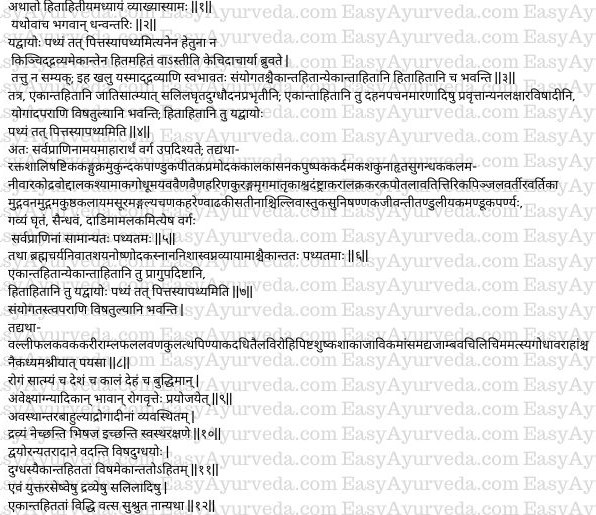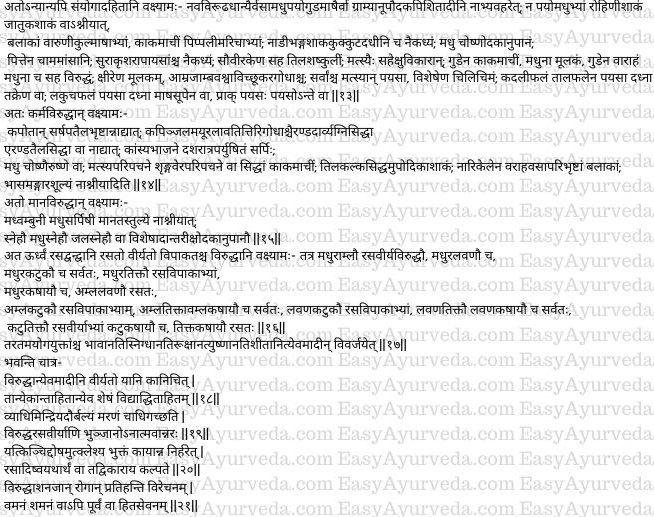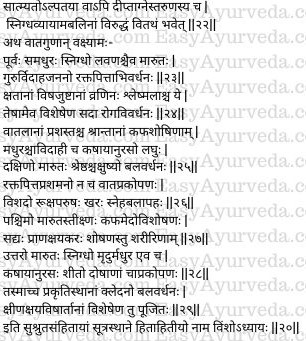This article explains Sushruta Samhita Sutrasthana Chapter 20 “Hitahitiya Adhyaya” Suitable and unsuitable (for health).
Hitahitiya Adhyaya – Suitable and unsuitable (for health)
We will expound the chapter by name Hitahitya- suitable and unsuitable for health; as revealed by the venerable Dhanvantari.
Read – Lord Dhanwantari ‘The God of Ayurveda’
Dravya Bhedas
Kinds of substances
“Substances which are suitable to vata (medicines, foods, activities, behaviors etc.) are unsuitable to pitta”. Based on this principle some authorities (masters) opine that no substances (in the world) are either absolutely or always, completely or surely ‘suitable or unsuitable’ at all times and in all conditions and for all individuals.
This opinion seems to be incorrect. Because according to the Dhanvantari school, all substances by their nature and as a result of their combination (or by chance) are always either absolutely suitable, absolutely unsuitable or absolutely both suitable and unsuitable (as per situation, need or usage).
Ekanta–Hita– Absolutely suitable means those which do not harm the body in spite of them being always used.
Ekanta Ahita – absolutely unsuitable means those which harm the body quickly and so cannot be used even for short periods.
Hitahita – suitable-unsuitable, are those which do not harm in certain conditions (proper quantity, time, season, admixture, processing etc) but cause harm in certain other conditions (improper quantity, time, season, admixture, processing etc).
Thus, substances are of three kinds.
Read – Dravya: Meaning, Ayurvedic Explanation
Ekanta Hita Dravya
Substances which are always suitable
Among these, substances like water, ghee, milk, porridge (boiled rice) and similar others are always suitable because of being accustomed through lineage of generations (genetically accustomed over a period of generations) or accustomed to the man right from the birth.
Similarly, the substances like fire, caustic alkali and poison used for dahana (burning), pachana (cooking) and marana (causing death) respectively are (completely, surely) and always unsuitable.
Due to combination some suitable substances also act similar to poison. Therefore, they are also always unsuitable.
The substances which are both suitable and unsuitable are those which are mentioned as suitable to Vata and unsuitable to Pitta etc.
Read – Rasa Panchaka – 5 Qualities Of Substance (Dravya)
Pathyatama Ahara
Food materials which are best suited for health
So, further on, is enumerated such substances which are useful as food for all living beings, such as –
- Raktasali, Sastika, Kanguka, Mukhundaka, Panduka, Pitaka, Pramodaka, Kalaka, Asanapuspaka, Kardamaka, Sakunahrta, Sugandhaka, Kalama (all are different varieties of Paddy / rice),
- Nivara, Kodrava, Uddalaka, Syamaka (all are millets),
- Godhuma (wheat), Yava (barley), Venu Yava (seed of bamboo tree);
- Meat of Ena, Harina, Kuranga, Mrgamatrka, Svasamstra, Karala (all are different kinds of deer), Krakara, Kapota, Lava, Tittiri, Kapinjala, Vartira, Vartika (all are varieties of birds);
- Mudga, Vanamudga, Makustaka, Kalaya, Masura, Mangalya, Canaka, Harenu, Adhaki, Satina (these are legumes / pulses)
- Cilli, Vastuka, Sunisannaka, Jivanti, Tanduliyaka, Mandukaparni (these are leafy vegetables),
- Cows’ ghee
- Saindhava
- Dadima and
- Amalaka
The substances of this group are generally best suited to all living beings.
Similarly, the below mentioned are also best suited always –
- celibacy,
- sleeping at a place devoid of breeze,
- bathing in hot water,
- sleeping at nights,
- physical exercises etc.,
Those that are always suitable and always unsuitable were enumerated earlier, suitable –unsuitable are those which are described (in the texts) as suitable to vata but unsuitable to pitta and so on.
Read – How To Balance Vata Dosha? Line Of Treatment And Reasoning
Samyoga viruddha
Incompatible by combination
Some substances in combination with some others become similar to poison (in effect) such as; Valliphala (fruits of creepers) Kavaka, Karira, Amla Phala (sour fruits), Lavana (salts) Kulattha, Pinyaka (paste of tila) Dadhi (curds), Taila (oil), Virohi (germinated grains), Pista (flour), suska saka (dried leafy vegetables), meat of goat and sheep, wine, Jambuphala, cilicima matsya (kind of fish), meat of Godha (Iguana), Varaha (boar) etc. should never be consumed along with milk.
Factors to consider before administering these substances
After carefully considering his diseases, habituation, accustoms, habitat (region), time (seasons), body (physical constitution), digestive fire and other aspects the intelligent physician may administer these substances to the patient.
Since the stages of diseases etc (factors mentioned above) are large in number, physicians do not like to discriminate against the substances (as always suitable or always unsuitable or suitable unsuitable) but wish to consider either of them for protection of health.
From the perspective of (administering these to) the patients, if the physician needs to select any one, he will obviously pick milk which is always suitable and not the poison because it is always unsuitable.
Dear son Sushruta, in this manner one should understand and consider the substances such as water etc, having normal tastes as always suitable (to health) and not otherwise (when abnormal in taste etc).
Read – Bad Food Combinations and Solution as Per Ayurveda
Samyoga Viruddha
Incompatible by combinations
Further on, we will describe some other substances, which are unsuitable (for health), in their combinations, such as the following: –
Meat etc. (blood, fat marrow) of animals’ lives in marshy lands and water should not be consumed combined with freshly harvested grains, sprouted grains, muscle fat, honey, milk, jaggery and black gram.
Rohinisaka or jatukasaka, should not be consumed along with milk or honey.
Meat of balaka should not be consumed with varuni (a type of alcohol / wine) and kulmasa (half boiled grains).
Kakamaci should not be consumed along with Pippali and Marica.
Nadibhangasaka, should not be taken with meat of cock and curds mixed together all at once.
Hot water as an after-drink should not be taken after consuming honey.
Uncooked meat should not be taken along with pitta (bile).Sura (beer), Krsara (rice boiled along with green gram or black gram) and Payasa (milk pudding) should not be mixed together all at once.
Tila Saskuli (paste of sesame fried in oil / ghee) should not be consumed along with Sauviraka (a kind of gruel).
The products of sugarcane (jaggery, sugar etc.) should not be taken along with fish.
Kakamaci should not be consumed along with jaggery.
Mulaka should not be taken with honey.
Boar meat should not be eaten along with jaggery or honey.
The below mentioned should not be taken along with milk –
- Mulaka
- fruit of Amra and Jambu
- meat of porcupine, boar and Iguna
All kinds of fish should not be taken along with milk, especially the cilicima fish.
Fruits of Kadali and Tala should not be taken along with milk, curds or buttermilk.
Fruit of lakuca should not be taken together with milk, curds or soup of Masa. Likewise, lakuca fruit should not be consumed before or after taking milk.
Read – Importance Of Diet (Pathya Apathya) For Specific Diseases
Karma viruddha
Incompatible by processing
Now, we will explain incompatible foods based on their processing.
Meat of Kapota fried in mustard oil should not be partaken.
Meat of Kapinjala, Mayura, Lava, Tittiri and Godha cooked with fuel (wood) of Eranda or Darvi or cooked in castor oil should not be consumed.
Ghee kept in a bronze vessel for ten days or more should not be consumed.
Honey should never be consumed with hot substances or in hot seasons.
Kakamaci cooked in a vessel in which fish or ginger was cooked should never be consumed.
Upodika saka prepared with paste of tila should not be consumed.
Meat of balaka bird fried in fat of boar and added with Narikela should not be taken. Meat of bhasa bird pierced by iron rods and roasted in flame should not be consumed.
Read – Diet And Lifestyle For Women In Ayurveda
Mana viruddha
Incompatible by proportion
Next, we will enumerate incompatible foods (combinations) by their quantity / proportion. Honey and water, honey and ghee mixed in equal quantities should not be consumed. Two snehas (fat), honey and fats or fats and water, especially rain water mixed in equal quantities should not be consumed after drinking.
Rasa Viruddha
Incompatible by tastes etc
Now we will describe incompatibility in respect of combination by taste, potency and taste after digestion as follows. Mixtures of two tastes viz, sweet and sour or sweet and salt are incompatible in respect of taste and potency. Sweet and pungent tastes mixed together are incompatible in all respects (taste, potency, and taste after digestion). Mixture of sweet and bitter tastes is incompatible in terms of taste and taste after digestion. Sweet and astringent tastes are incompatible in respect of taste and so is the combination of sour and salt tastes. Sour and pungent tastes are incompatible in terms of taste and taste after digestion. Mixture of sour and bitter tastes and mixture of sour and astringent tastes are incompatible by all respects. Mixture of salt and pungent is incompatible in terms of taste and taste after digestion. Combination of salt and bitter and mixture of salt and astringent tastes are incompatible in all respects. Pungent and bitter taste combination is incompatible with respect to taste and taste after digestion, so is the mixture of pungent and astringent tastes. Mixture of bitter and astringent tastes is incompatible in terms of taste.
Read – Food Poisoning: Ayurvedic Concept, Remedies, Herbs, Diet
Combinations which need to be avoided
Among the combinations, those which are profound and more profound in respect of their various aspects (taste, potency, and taste after digestion) such as too much of unctuousness, or too much of dryness, too much of heat or too much of cold etc. should be avoided.
Those substances which are described as incompatible by potency, should be understood as absolutely (always) unsuitable (to health), while all the remaining (substances) should be understood as suitable and / or unsuitable.
Read – Veerya, Potency Of Herbs And Doshas – Inter-relationship
Consequences of consuming substances having incompatible tastes and potency
The person who without self-restraint consumes substances which are incompatible in respect of tastes and potency becomes a victim of diseases, debility of sense organs (improper sense perceptions) and even death.
Those substances which when consumed will cause increase (aggravation) of the doshas but will not expel them out of the body. These doshas which are not removed from the body would contaminate the rasa and other tissue in the body and would bring about abnormalities in them and give rise to many diseases.
Diseases arising from consuming incompatible foods will get cured by purgation, emesis or alleviating therapies, or by the use of suitable substances (conducive to health) right from the moment of commencement (of the diseases) itself.
Read – Benefits of Vamana and Virechana Treatment – Charaka Sutrasthana 16
Persons who are not harmed by incompatible foods
In the below mentioned conditions and persons even the incompatible foods (when consumed) will become ineffective (will not harm the body) –
- due to satmya or being accustomed / habituated to incompatible foods for a long time
- when consumed in small quantities
- when consumed by the person who has keen digestive fire (digestive capacity),
- in a young person
- in those who have become strong by the effect of using unctuous (fatty) foods and physical exercises



Vataguna
Properties of breeze
Breeze from the east is – sweet (pleasant), unctuous and salt, heavy, produces burning sensation, and aggravates Rakta (blood) and Pitta always. It exacerbates the diseases of those suffering from wounds, poison, ulcers and of persons of Kapha (constitution). It is good for persons of Vata constitution, the fatigued and those in whom the kapha has dried up. But if these people are having ulcers / wounds, this breeze will increase the moistness in those wounds.
Read – Diet And Lifestyle Advice For Vata Dosha Body Type
Breeze from the south – is sweet, does not cause heartburn, will have astringent sub-taste, is light; it is best for health, good for eyes (vision), enhances strength, alleviates rakta (blood) and Pitta, and does not aggravate Vata.
Breeze from the west – is clear / calm, dry, rough, strong, decreases unctuousness and strength, is penetrating, dries up Kapha and medas (fat), reduces Prana (strength) and causes emaciation.
Breeze from the north – is unctuous, soft, sweet, astringent in secondary taste, cold, does not aggravate the Doshas, hence it causes moistness and enhances strength in healthy persons, it is beneficial especially for those suffering from emaciation, consumption and poison.
Thus ends the Twentieth chapter by name Hitahitiya- In Sutra Sthana of Susruta Samhita.




